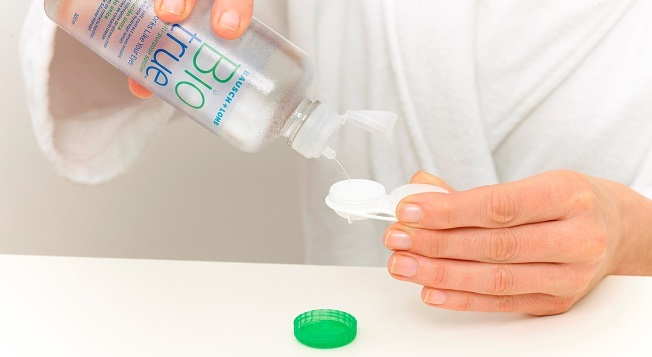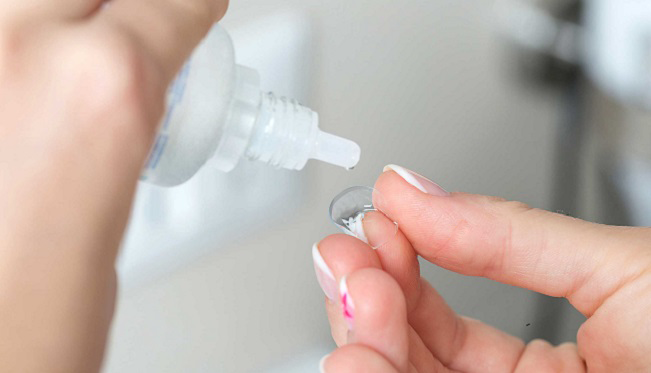The Basics of Soft Contact Lens Care: Clean, Rinse And Disinfect
1. Wash your hands so that you don’t transfer dirt and germs to your eye. Try to avoid moisturizing soaps, as they are not good for contact lenses. Dry your hands with a lint-free towel.
2. Remove one lens and clean it with the recommended solution. Cleaning removes eye-produced buildup, cosmetics and other debris that impairs lens comfort. The FDA recommends that you rub the lens in the palm of your hand with a few drops of solution, even if you are using a “no-rub” product.
3. Rinse the lens again to remove the loosened debris, making sure to take as long as the package directs: Rinsing is an important step.
4. Place the lens in your clean lens case or lens holder and fill with fresh solution; don’t “top off” your old solution. Disinfecting kills microorganisms on the lens. Disinfection time varies from product to product; check the package for details.
5. Repeat steps two through four for your other lens.
The Products: Cleaning, Rinsing And Disinfecting Solutions
Saline solution: is for rinsing and storing contact lenses, when you’re using a heat or UV disinfection system. You also may need it for use with enzymatic cleaning tablets or cleaning/disinfecting devices. Never use saline products for cleaning and disinfection.

Daily cleaner: is for cleaning your contact lenses. You place a few drops in the palm of your hand and carefully rub the lens for as long as directed, usually around 20 seconds, making sure to clean both sides. Use other products for rinsing and disinfection.
Multipurpose solution: is for cleaning, rinsing, disinfecting and storing your contact lenses. Clean your lenses as you would with daily cleaner, then rinse (as long as directed) and disinfect, all with the same solution; or rinse the lenses twice, then place them in the clean lens case with solution to clean and disinfect. When you are ready to wear the lenses, rinse them again. With multipurpose solutions, no other lens care products are necessary.
Hydrogen peroxide solution: is for cleaning, disinfecting, rinsing and storing your contact lenses. With this product, you place your lenses in the provided basket and rinse them, then place the basket in its cup and fill the cup with solution to clean and disinfect your lenses.After the disinfection and neutralizing step is completed, you can remove the lenses from the case and put them on.
Never rinse your contacts with hydrogen peroxide solution and apply them directly to your eyes without completing the entire disinfecting and neutralizing step. Doing so can cause a painful chemical injury to the eye.
Contact Lens Care Must-Knows
Once you’ve decided which product you’d like to try, discuss your plans with your eye doctor. Don’t switch brands until you determine that the new brand is compatible with your other products and with your contact lenses.
Regardless of which care regimen or brands you use, remember:
Never touch solution bottle tips to any surface, including your body: this can cause contamination of the solution.

Avoid getting tap water on your contact lenses and accessories, as it can carry a microorganism called Acanthamoeba that causes serious eye infections.
Remember to clean your contact lens accessories (lens case, cleaning/disinfecting devices, enzymatic cleaner vials and so on) as directed.
Lens cases should be rinsed with hot tap water and dried when not in use. (Because Acanthamoeba cysts may be present in tap water and can survive for years after drying, some eye doctors recommend using only contact lens disinfecting or multipurpose solution for this step.)
Recent studies suggest that wiping your case with a clean tissue and/or placing it upside-down on another clean tissue may be additional good steps in keeping bacteria biofilms off the case. Ask your eye doctor what he or she thinks.
Throw out your contact lens case every three months to reduce your risk of infection.
Most importantly, clean and disinfect your contact lenses once a day. If you wear extended wear contacts, clean and disinfect the lenses as soon as you remove them, unless they are designed to be discarded immediately after use. Not only will your eyes be safer and healthier, but your contact lenses will be more comfortable to wear, too.
Source.Allaboutvision


